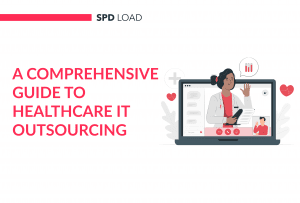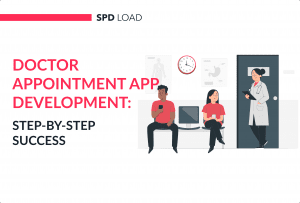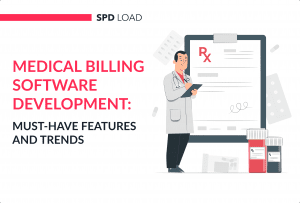ERP Development From Scratch: Tips, Costs, and Challenges
- Updated: Nov 14, 2024
- 15 min
Data is the lifeblood of every company.
But managing that data across various departments can be overwhelming without the right tools.
That’s where ERP software comes in.
It centralizes everything — finance, HR, supply chain, and more — into a single system to make it easier to collect, organize, analyze, and distribute information.
If you or your clients are struggling with disconnected data sources or inefficient processes, a well-designed ERP software can streamline business operations and boost productivity.
In this article, we’ll walk you through the key steps of ERP development so that you can better understand how to create a solution tailored to your business needs.
We will also explore the ERP software market, the benefits of ERP systems, key features companies are looking for, as well as challenges of ERP software development.
You can also explore these practical app development tips to keep your project on track and on budget.
Let’s go!
Explore our SaaS services today
What is ERP Software Development?
ERP stands for enterprise resource planning.
This is a type of software that companies use to manage their daily business activities.
ERP systems allow to manage procurement, accounting, project management, compliance, risk management, supply chain operations, and more.
A complete ERP suite also includes enterprise performance management and software that helps plan, budget, predict, and report on an organization’s financial results.
Overall, ERP systems tie together a multitude of business processes and enable the flow of data between them.
This is what makes enterprise resource planning software a must-have for many organizations.
ERP systems collect an organization’s shared transactional data from multiple sources. This way, the software eliminates data duplication and provides integrity with a single source of truth.
Today, ERP systems help to manage thousands of businesses of all sizes and in all industries.
To these companies, ERP is as indispensable as the electricity that keeps the lights on.
Let’s see what are the market predictions for ERP software.
ERP Software Market Size
According to the recent Market.Us report, the ERP software market is experiencing significant growth.
It is projected to reach $136.1 billion by 2032, growing at an impressive 10.5% annually.
This growth is fueled by several factors.
Among them are the rising popularity of cloud-based app development and mobile app integration.
These technological advancements help businesses operate more efficiently.
Another factor is business automation.
Many companies, especially in manufacturing, are automating their processes to stay competitive.
ERP systems help streamline everything from inventory management to logistics management software for supply chain logistics. This helps to improve the efficiency of business operations and reduces the chances of human error.
Automation is particularly important in emerging markets like Asia-Pacific, where industries are rapidly modernizing.
The research highlights that custom ERP software development is in high demand across the finance sector and large enterprises.
The finance industry holds 26% of the market, while enterprises make up 39% of the ERP software user base.
It is important to note that cloud-based ERP is also gaining traction in medium-sized businesses as it offers cost savings and quicker delivery times. 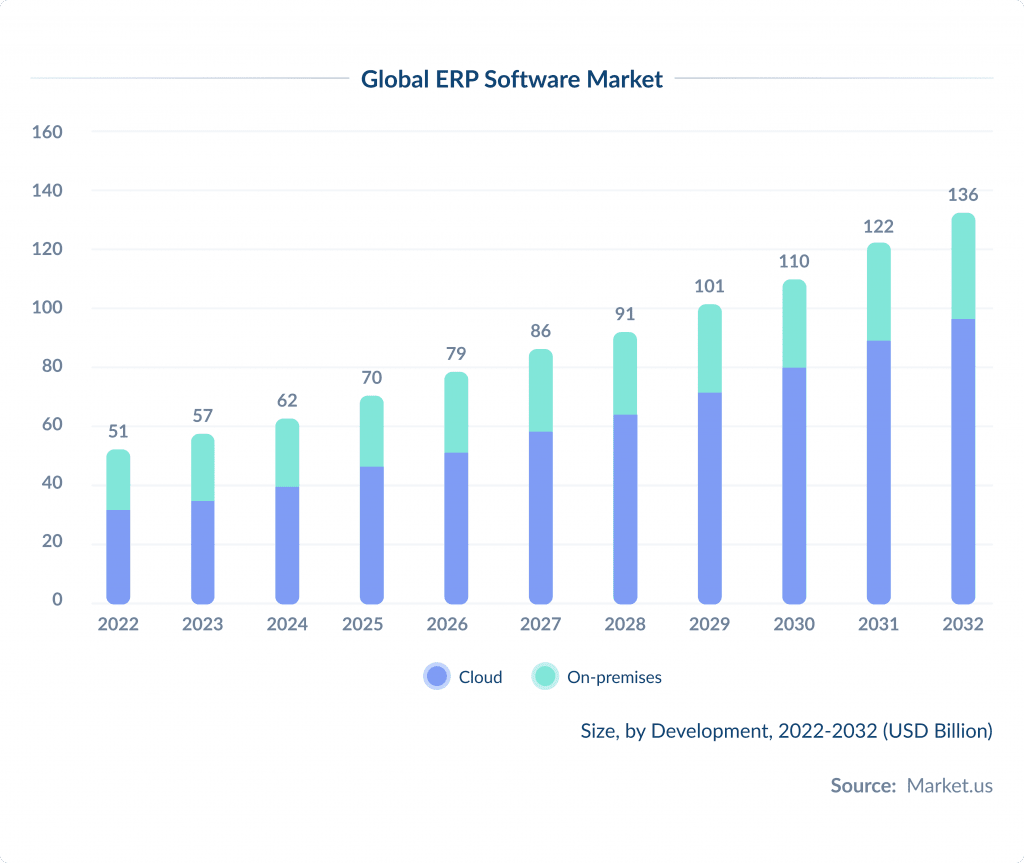
Innovation is the key to leadership. Here’s how to win the technology race in the healthcare industry.
So, if you have been wondering if ERP software is in demand now and whether there is a growing need for innovative ERP solutions, the answer to both questions is YES.
Now, let’s explore the features that will make a great ERP software that will be competitive.
Must-have Features and Modules of Custom ERP Software
As we’ve mentioned above, ERP systems are designed around a single data structure that typically has a common database.
This way, you can make sure that the information used across the enterprise is set and based on common definitions and user experiences.
Then, these core constructs are interconnected with business processes driven by workflows across business departments (e.g. HR, accounting, marketing, operations, etc).
This way, all these systems and the people who use them are connected.
Simply put, ERP is the vehicle for integrating people, processes, and technologies across a modern enterprise.
If you’re looking to build custom ERP software, it’s essential to include certain key features that will streamline your business operations.
Here’s what a great ERP software should offer to its customers:
Financial Management
This feature gives you a clear view of your company’s finances, from income and expenses to assets and liabilities.
It centralizes all financial data, making it easier to track budgets, manage cash flow, and oversee expenses across different departments.
With integrated financial management, businesses can create real-time reports that support quicker, data-driven decisions and financial transparency.
This module also automates repetitive tasks like payroll, invoicing, and reconciliation.
Overall, financial management in ERP ensures that all financial operations align with business goals, providing a clear and accurate financial picture at any moment.
Inventory Management
Inventory management makes sure you never overstock or run out of key items.
It gives you real time stock levels so you can get the balance right.
McKinsey Research shows that using inventory software can reduce excess stock by 15-30%.
So instead of guessing, your ERP system can tell you when to reorder products so you can always have enough for customers without tying up too much cash in extra stock.
Customer Relationship Management (CRM)
It can help you identify sales opportunities and build stronger relationships.
Businesses using CRM see a boost in sales and an increase in customer satisfaction.
With a CRM, your team has instant access to customer preferences and purchase history, so they can offer more personalized service — something customers really appreciate.
If you’re interested in how to build CRM from scratch, our guide will give you all the tools and insights you need.
Human Resource Management (HRM)
Managing employee records, payroll, and benefits is a breeze with HRM.
It automates time-consuming tasks like time tracking and performance reviews, giving you more time to focus on your people.
According to PwC, automating HR processes can cut administrative costs by 30%.
Plus, it ensures you’re staying compliant with labor laws and simplifies complex processes like hiring or promotions.
We have explored the benefits of human resource management systems in our recent article. There, we’ve highlighted the importance of HRMS, what are the core functions and must-have features.
Supply Chain Management (SCM)
Supply chain management makes sure every step, from purchasing to production to logistics, runs like clockwork.
With SCM, you can reduce lead times, streamline production, and build stronger relationships with suppliers.
This means you’ll be better positioned to meet customer demands without delays, all while cutting down on unnecessary expenses.
Business Intelligence (BI) and Reporting
With BI tools like Power BI and Tableau, companies can analyze patterns and trends.
This helps them to make better, data-driven decisions about everything from inventory to sales strategy.
Real-time reporting, in its turn, allows teams to access up-to-date metrics, so they can react quickly to changes in the market or within the organization.
This feature helps identify areas for improvement, predict future demands, and optimize operations.
BI and Reporting empower businesses to stay competitive and proactive.
Discover other healthcare technology trends that are shaping the future of health services.
Integrations
A good ERP system connects with the other tools you use — like e-commerce platforms, payment systems, or 3rd party logistics providers.
This integration means data flows between systems without manual input, and it saves time and helps to reduce human errors.
With everything working together, you can focus on growing your business, not managing data transfers.
Healthcare data analytics is transforming the industry, making it possible to improve care and make smarter decisions. Learn more about its impact in our guide on healthcare data analytics.
Mobile App Solution
Having a mobile ERP app keeps your team connected wherever they are.
Whether someone is on the road or in a meeting, they can still access information, approve transactions, or update records in real-time.
Businesses with a mobile ERP system report a 34% increase in workforce productivity (TechJury). 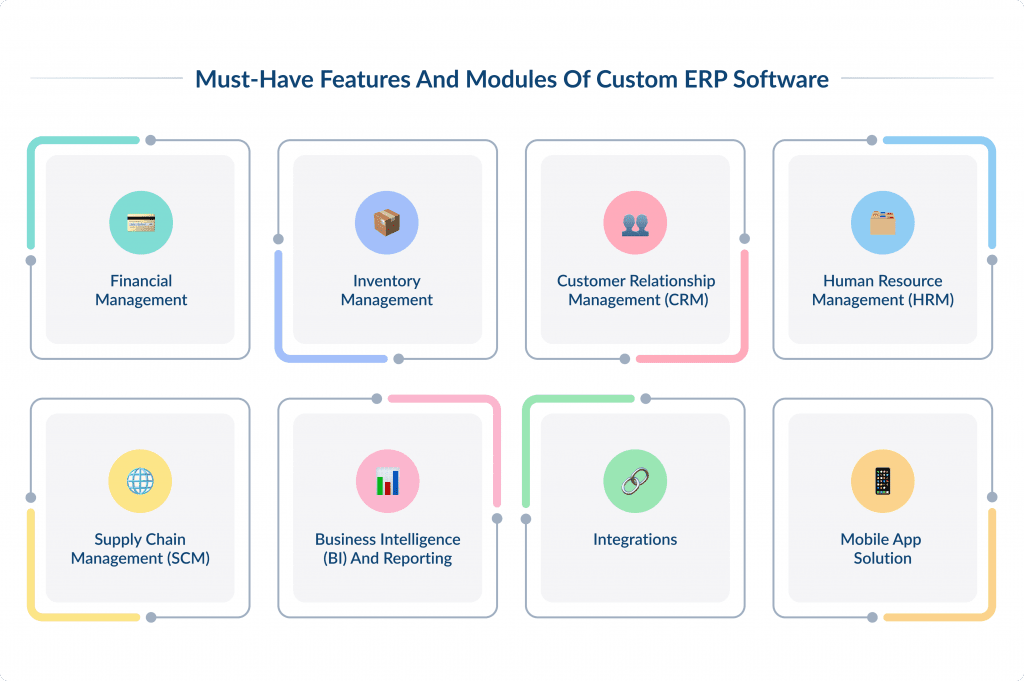
ERP Software Development Process: Step-by-Step Guide
Custom ERP software development is a complex process that involves multiple stages.
Here, we explore 8 stages of ERP software development, such as to help you better understand the process.
Find out how long it really takes to develop an app with our comprehensive guide on how long it takes to develop an app.
Step | Description | Value |
|---|---|---|
1. Clarify Requirements and Expectations | Are you developing an ERP system for your internal needs, or you want to provide it as a SaaS product (check our what is SaaS product)? Define your expectations from the start to increase your chances of success. | Set clear goals and expectations to make sure that the system you want to build solves real problems, and not just adds more complexity. |
2. Research the Market | Research what ERP solutions competitors use and what features are trending in your industry. Tools like Gartner, Statista, and Google Trends are great for market research. You can also gather insights from stakeholders — maybe through interviews or surveys — to figure out what features they’d actually use. | A thorough market research will help you avoid building a solution no one really needs. |
3. Map Out Core Functionality for an MVP | Rather than trying to build the full system right away, it’s better to start with an MVP (Minimum Viable Product). Software MVP development includes just the core features that provide immediate value. In your care, it can be finance management or tracking inventory. | Starting small allows you to get the system up and running quickly, so you can test it out and gather feedback early on. Plus, adding only essential features first helps you avoid overwhelming users with unnecessary complexity. |
4. Sketch the ERP System Design | This is where you map out how the ERP will look and feel. The goal is to make it user-friendly and easy to navigate, so your teams don’t feel lost when they log in. | Think of this step as creating the blueprint for a house — you want to make sure it’s functional and intuitive before you start building. Explore examples of good web design that combine functionality and creativity |
5. Choose the Right Tech Stack | The tech stack is like the engine under the hood. Choosing the right technology is crucial for making sure your ERP system is fast, secure, and scalable. For example, you might use Node.js or Django for the backend, and React or Angular for the frontend (Get the details on the cost to hire a React.js developer and what factors can influence rates) If you plan on hosting the system in the cloud, platforms like AWS or Azure are good options. Discover the strengths and weaknesses of Digital Ocean, AWS, and Google Cloud to find your ideal match. | Pick modern, reliable technologies to make sure your ERP can grow with your business without breaking down. Learn more about how to choose a tech stack. Selecting the right hosting solution is key to your SaaS success. Learn about the best options in our guide to hosting for SaaS. |
6. Initiate Development and Design | This is where your development team starts building the system. An agile discovery process works best here. You simply break the project down into small, manageable chunks (sprints). This allows for flexibility and quick adjustments. The MVP features get built first, and designers make sure everything looks clean and is easy to use. | It’s an exciting phase, as you start to see all the planning come to life! MVP development typically takes around 6 to 12 months, depending on the scope of work and your software development team structure and size. Learn more about how to launch an MVP. Whether you’re a startup or a seasoned pro, this guide on MVP design will save you time and money. |
7. QA & Testing | Testing is critical, and there are a few types you’ll want to focus on:
| Tools like Selenium or Postman are commonly used in ERP testing, and they help catch issues before they become big problems. Want to boost your startup’s success? Try these five usability testing ways to ensure a seamless user experience. |
8. Analyze Feedback and Iterate | Are there features they love? Things that are missing? The goal is to listen closely and make adjustments based on real user experience. | This step helps ensure that the ERP continues to grow with your business and meets evolving needs. |
Take your time through each of these steps.
Make sure that the ERP system you develop isn’t just functional — it’s a tool that truly makes life easier for your team and helps the business run more efficiently.
Start small, test thoroughly, and constantly improve based on feedback.
This will help you build an enterprise resource planning ERP that’s perfectly tailored to your organization. 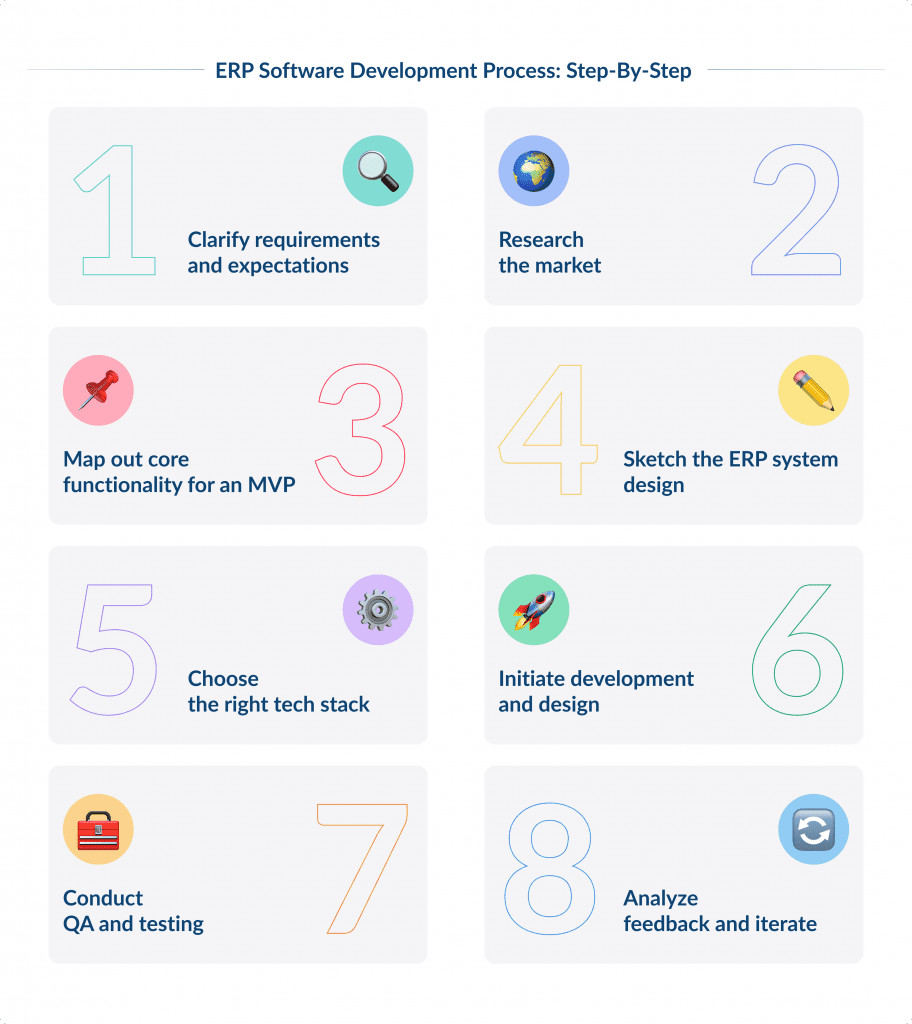
What’s the Average Cost of Custom ERP Solutions?
The answer to this question is rather complex.
The thing is that the ERP development cost depends on multiple factors such as app complexity, the location of the development team, the number of developers you need, the tech stack you choose, and so on.
Let’s unwrap what is the average price to develop enterprise resource planning software.
An MVP for custom ERP solutions for small businesses ranges between $50,000 and $150,000.
The cost is lower due to fewer users, simpler functionality, and shorter development times.
For medium-sized businesses, custom ERP software tends to cost between $200,000 and $500,000.
These systems are more complex and often involve integrations with other business systems like CRM, HR, and supply chain management.
For large enterprises, the ERP software development cost can be over $500,000.
These systems often need to be highly customized, support thousands of users and require extensive integrations with various systems across different departments.
Need a reliable development team? Here’s your step-by-step guide to hiring a dedicated team in Ukraine.
Breakdown of ERP Development Costs
ERP development is much more than just coding and design.
Here are other factors that influence the final price of your solution to handle business processes:
Software Development
A significant portion of the cost comes from the custom development process itself.
This typically includes planning, design, development, testing, and deployment.
Licensing
If you’re integrating third-party tools, licensing fees can add up.
For example, an ERP solution might require integrations with cloud platforms, databases, or specific APIs.
Implementation & Training
ERP systems often require substantial time and effort for implementation, including data migration, setting up workflows, and training employees.
Implementation costs can range from 50-100% of the software costs, according to Panorama Consulting Group.
Maintenance & Support
Ongoing costs to maintain, update, and support your ERP system usually fall between 15-20% of the initial implementation costs per year.
If you still hesitate whether you need to build your own ERP software or use an already existing one, here are a few things to take into consideration. 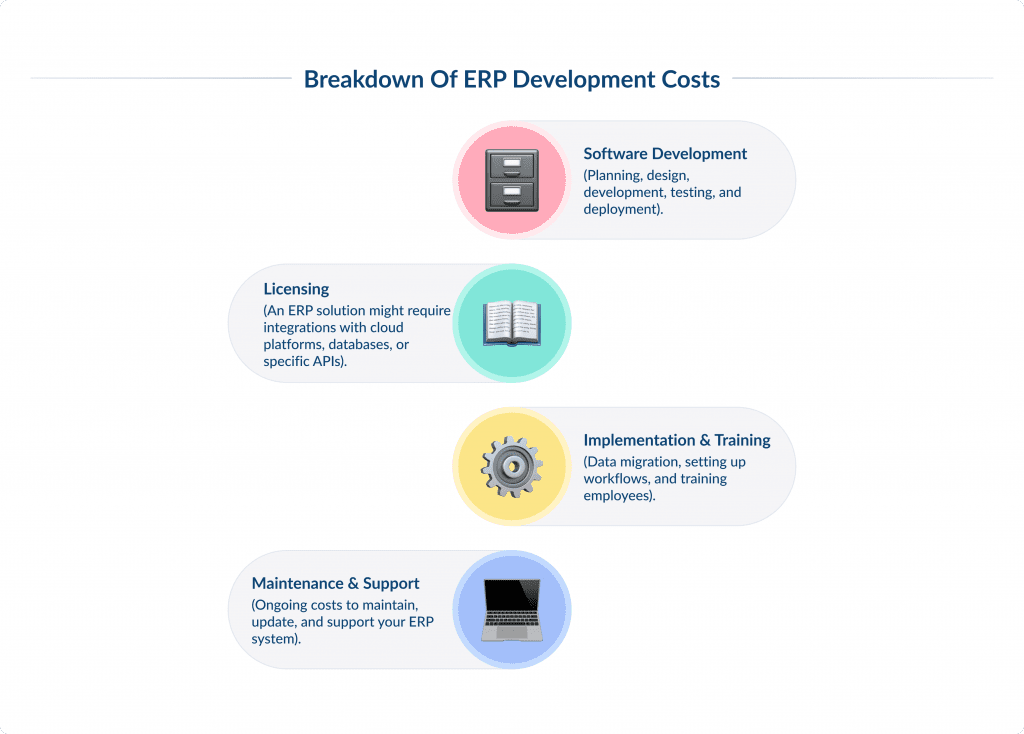
Custom vs Off the Shelf ERP Systems: Which One to Choose?
When making your choice between custom and off-the-shelf ERP software, it really comes down to two things:
- What are your business needs?
- How much flexibility are you looking for?
A custom ERP is built to match your business processes perfectly.
That means it can adapt as your company grows or evolves.
But ERP system development takes more time and money than pre-made solution.
Plus, you’ll need to keep it updated regularly to make sure it keeps working smoothly, that can be a hurdle.
Overall, a custom ERP system is an ideal option if your business has unique needs that generic solutions can’t cover.
On the flip side, off-the-shelf ERP is ready to go right away, often cheaper, and quicker to implement.
But it may not fit your business perfectly, which means you might have to adjust how you work to fit the software.
This option is great for companies looking for a quicker, more budget-friendly solution that doesn’t require a lot of customization.
Discover why healthcare IT outsourcing is becoming a game-changer for healthcare organizations.
Challenges of Building a Custom ERP Solution
Beyond the money matters, custom ERP software development comes with several challenges.
Here are some of the key difficulties you might want to keep in mind:
ERP Software is Complex to Develop
ERP systems integrate multiple functions like finance, HR, inventory, and supply chain management all into one platform.
If your software development partner hasn’t built such type of systems before, it can be hard for them to coordinate these diverse areas.
That is why you need to check their expertise before signing a contract.
Picking the right partner is crucial — here’s how to choose an app development company that fits your needs.
Also, when collaboraintg with an outsourcing partner, be involved in the feature planning to make sure your future custom ERP system will meet all your needs.
Discover the benefits of IT outsourcing and why it’s popular for scaling tech needs.
User Adoption and Training Can Take a While
Once your ERP software is built, it can be difficult to get employees to fully adopt the system.
ERPs often require significant training, and employees may resist using a new system, especially if it’s complex or disrupts their routine.
In general, it can take teams a few days to several weeks to master the ERP software.
Everything depends on the complexity of the system and the specific roles of the employees. 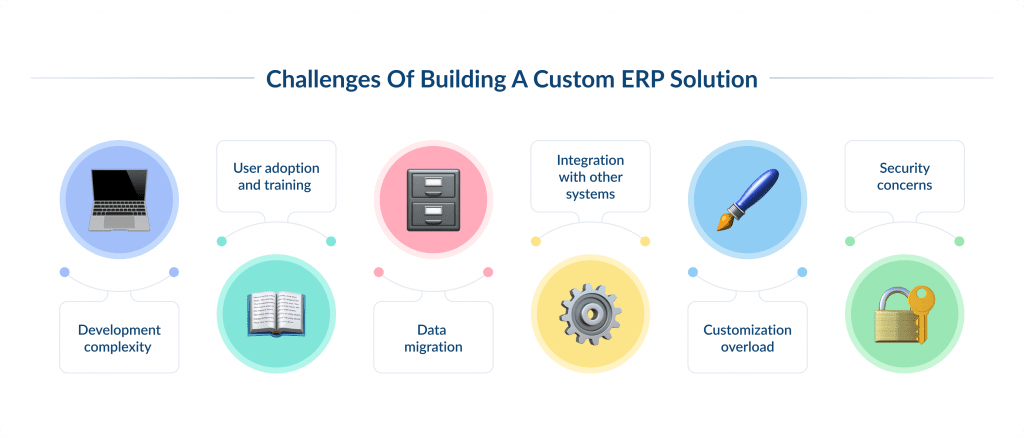
Data Migration
Moving all your existing business data into a new ERP system is a major task.
It can be challenging to ensure all data is properly transferred, clean, and formatted correctly without losing anything critical.
Integration with Other Systems
ERP software often needs to integrate with other tools, such as CRM, e-commerce platforms, or third-party APIs.
It can be technically hard to ensure a smooth integration, especially if the external systems are outdated or complex.
Want to join the booming eCommerce market? Learn how to develop an eCommerce app that meets customer needs.
Customization Overload
While customization is a major benefit of building your own ERP, over-customization can lead to feature bloat and performance issues.
It can also make future updates or scaling more complicated and expensive.
Explore our HR development services today!
Security Concerns
ERPs handle sensitive data, from financial records to employee information.
You want to make sure your ERP software is secure and reliable.
To do so, we implement encryption and access controls, among other security measures.
However, it might be challenging to maintain the system security without specialists who know the system well.
Explore our guide to cybersecurity trends and see what your organization needs to stay secure.
How to Choose a Custom ERP Software Development Company?
The key to business success is a great idea plus top-notch implementation.
You have an idea for ERP software, now it is time to find a team that can make it real.
Dreaming of creating a unicorn? Here’s how to find an idea for a unicorn startup.
At SpdLoad, we have been developing software across multiple industries for over ten years.
We know the struggle when it comes to a software development partnership.
Here are a few things you want to keep in mind when deciding on your IT outsourcing provider:
| Factor | Why It’s Important | What You Should Look For |
|---|---|---|
| Industry Know-How | A company with experience in your industry gets your unique needs. | Look for companies with a track record in your field, showing real examples of ERP solutions they’ve built for similar businesses. |
| Technical Skills | The right technology ensures your system is fast, reliable, and future-proof. | Ask about their experience with key technologies like .NET, Java, or cloud platforms like AWS and Azure. The better they know the tech, the better your ERP will perform. |
| Customization | Your business is unique, and your ERP should fit like a glove. | Make sure they’re offering custom solutions, not just tweaks to existing software. Ask for examples of systems they’ve built from scratch. |
| Ongoing Support | An ERP system isn’t a one-and-done project—it’ll need regular updates and support. | Check if they offer long-term support plans for maintenance, updates, and scaling your system as your business grows. |
| Clear Communication | Good communication keeps the project on track and ensures everyone’s on the same page. | Make sure they have a transparent process for regular updates and that they involve you in key decisions along the way. |
| Integration Skills | Your ERP has to work seamlessly with other systems like your CRM or HR tools. Check out these best HR software solutions that simplify HR tasks and improve productivity. | Look for a company that has experience integrating ERP systems with the tools you already use, like CRMs, payroll, or supply chain software. |
| Transparent Pricing | No one likes surprise fees — clear pricing helps you plan your budget. | Choose a company that offers a detailed cost breakdown upfront, so you know exactly what you’re paying for, with no hidden fees. |
| Security Focus | Your ERP will handle sensitive data, so it needs to be secure. | Make sure they prioritize data security with encryption, secure APIs, and regular security checks. You want your data to stay safe. |
| Client Feedback | Hearing from other clients can give you confidence in your choice. | Ask for references or read reviews from previous clients to see if the company consistently delivers what they promise. |
| Flexibility with Agile | You want the ability to make changes as you go, not be stuck in a rigid plan. | Look for companies that use agile development, which lets you adjust and refine the system throughout the project based on your feedback. |
You can also check out our guide on how to hire a dedicated remote team. There, we explore the remote hiring step by step.




